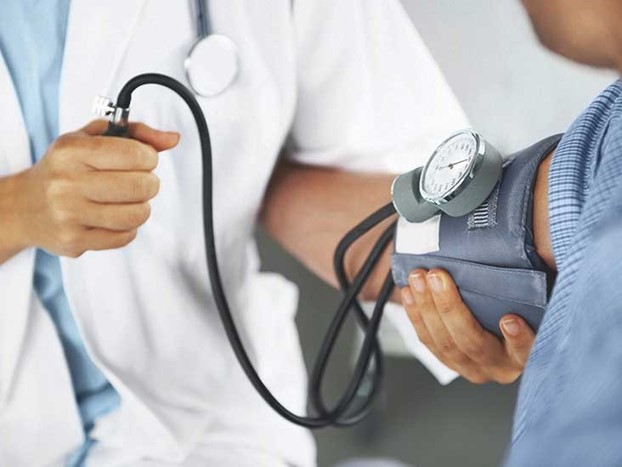The nurse observes the unlicensed assistive personnel (UAP) obtain vital signs on four adult clients.
For which client should the nurse intervene to redirect to use of proper method?
Using automatic BP cuff with shivering client with history of an irregular heart rate.
Pulling the client’s ear pinna backward, up and out to obtain a tympanic membrane temperature.
Counting the client’s radial pulse who is supine with the forearm straight alongside the body.
Counting the respirations for one full minute for a client with tachypnea.
The Correct Answer is A
Using an automatic BP cuff with a shivering client with a history of an irregular heart rate can result in inaccurate and low readings.

This is because shivering can interfere with the cuff inflation and deflation, and an irregular heart rate can affect the accuracy of the device.
The nurse should intervene and use a manual BP cuff with a stethoscope instead.
Choice B is wrong because pulling the client’s ear pinna backward, up and out to obtain a tympanic membrane temperature is the correct technique for adults and older children. This helps to straighten the ear canal and allow the light to reflect on the tympanic membrane, which shares the same vascular artery as the hypothalamus.
Choice C is wrong because counting the client’s radial pulse who is supine with the forearm straight alongside the body is an appropriate method.
The radial pulse can be easily palpated at the wrist, and the supine position and straight forearm do not affect the pulse rate.
Choice D is wrong because counting the respirations for one full minute for a client with tachypnea is a recommended practice.
Tachypnea means rapid breathing, and counting for one full minute can ensure accuracy and detect any variations in the respiratory pattern.
Nursing Test Bank
Naxlex Comprehensive Predictor Exams
Related Questions
Correct Answer is D
Explanation
The client with a labored respiratory rate of 28 should be seen first because this indicates respiratory distress, which is a life-threatening condition that requires immediate intervention. Respiratory rate is one of the vital signs that are used to assess the severity of a patient’s condition and to triage them accordingly. A normal respiratory rate for an adult is 12 to 20 breaths per minute.
Choice A is wrong because a large laceration on the left scapula is not as urgent as respiratory distress.
A laceration is a wound that involves a cut or tear in the skin, which may cause bleeding, pain, and infection. However, it can be managed with wound care and suturing in the urgent care center.
Choice B is wrong because a compound fracture of the right tibia is not as urgent as respiratory distress.
A compound fracture is a fracture that breaks through the skin, which may cause bleeding, pain, infection, and nerve or blood vessel damage. However, it can be stabilized with splinting and dressing in the urgent care center before transferring to a hospital for further treatment.
Choice C is wrong because being unable to breastfeed a 4 week old is not as urgent as respiratory distress.
Breastfeeding difficulties may be caused by various factors, such as poor latch, low milk supply, sore nipples, or mastitis. However, they can be managed with education, support, and medication in the urgent care center.
Correct Answer is A
Explanation
This statement suggests that the client needs further teaching because haloperidol is a medication that needs to be taken regularly and consistently to prevent relapse of symptoms related to schizophrenia. Stopping the medication abruptly can cause withdrawal effects and worsen the condition.
Choice B is wrong because it shows that the client understands the potential interaction between alcohol and haloperidol, which can increase the risk of sedation, drowsiness, and low blood pressure.
Choice C is wrong because it indicates that the client has realistic expectations about the onset of action of haloperidol, which can take several days or weeks to show improvement of symptoms.
Choice D is wrong because it demonstrates that the client is aware of the possible side effect of photosensitivity caused by haloperidol, which can make the skin more prone to sunburn and damage.
Haloperidol is an antipsychotic drug that works by blocking dopamine receptors in the brain. It is used to treat symptoms such as hallucinations, delusions, paranoia, and disorganized thinking in schizophrenia and other psychotic disorders. The normal dosage range for haloperidol is 0.5 to 20 mg per day, depending on the severity of the condition and the response to treatment. Some of the common side effects of haloperidol include extrapyramidal symptoms (EPS), such as muscle stiffness, tremors, restlessness, and abnormal movements; neuroleptic malignant syndrome (NMS), which is a rare but serious condition characterized by fever, muscle rigidity, altered mental status, and autonomic instability; and tardive dyskinesia (TD), which is a chronic movement disorder that involves involuntary movements of the tongue, lips, face, and limbs. Haloperidol can also cause weight gain, dry mouth, blurred vision, constipation, dizziness, insomnia, and sexual dysfunction.
Haloperidol should be used with caution in patients with cardiovascular disease, liver disease, seizure disorder, diabetes mellitus, thyroid dysfunction
Whether you are a student looking to ace your exams or a practicing nurse seeking to enhance your expertise , our nursing education contents will empower you with the confidence and competence to make a difference in the lives of patients and become a respected leader in the healthcare field.
Visit Naxlex, invest in your future and unlock endless possibilities with our unparalleled nursing education contents today
Report Wrong Answer on the Current Question
Do you disagree with the answer? If yes, what is your expected answer? Explain.
Kindly be descriptive with the issue you are facing.
